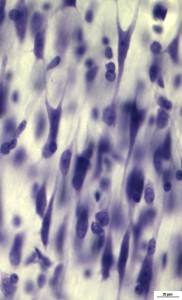Human uniqueness is often explained in terms of behavioral specializations such as language, empathy, and theory of mind. Comparative neurobiology investigates the foundation of these behavioral differences by comparing the human brain to that of other species. This summer I had the privilege to visit the the Mass Spectrometry Research Center at Vanderbilt University School of Medicine. I learned a method, matrix-assisted laser desorption ionization (MALDI) mass spectrometry, which enables the mapping of peptides and proteins across a two-dimensional slice of brain tissue. The method allows for the comparison of the relative quantities of a large number of proteins with a high degree of spatial resolution. When applied to the same functional region of the brain from two species, like a human and chimpanzee, the resulting mass spectrometry signal will help elucidate how these regions differ in their molecular expression between the two species.
Employing this method to address questions in human brain evolution is exciting because it encompasses so many aspects of neuroscience. Careful dissection of a region of interest, histological staining and examination of brain sections, and molecular analysis all come together in this project. Working on a project like this heightens my love for neuroscience while being able to ask one of the most interesting scientific questions: what makes humans unique? As a neuroscientist within the field of anthropology, I look forward to using other interdisciplinary methods to investigate questions within comparative neurobiology.


